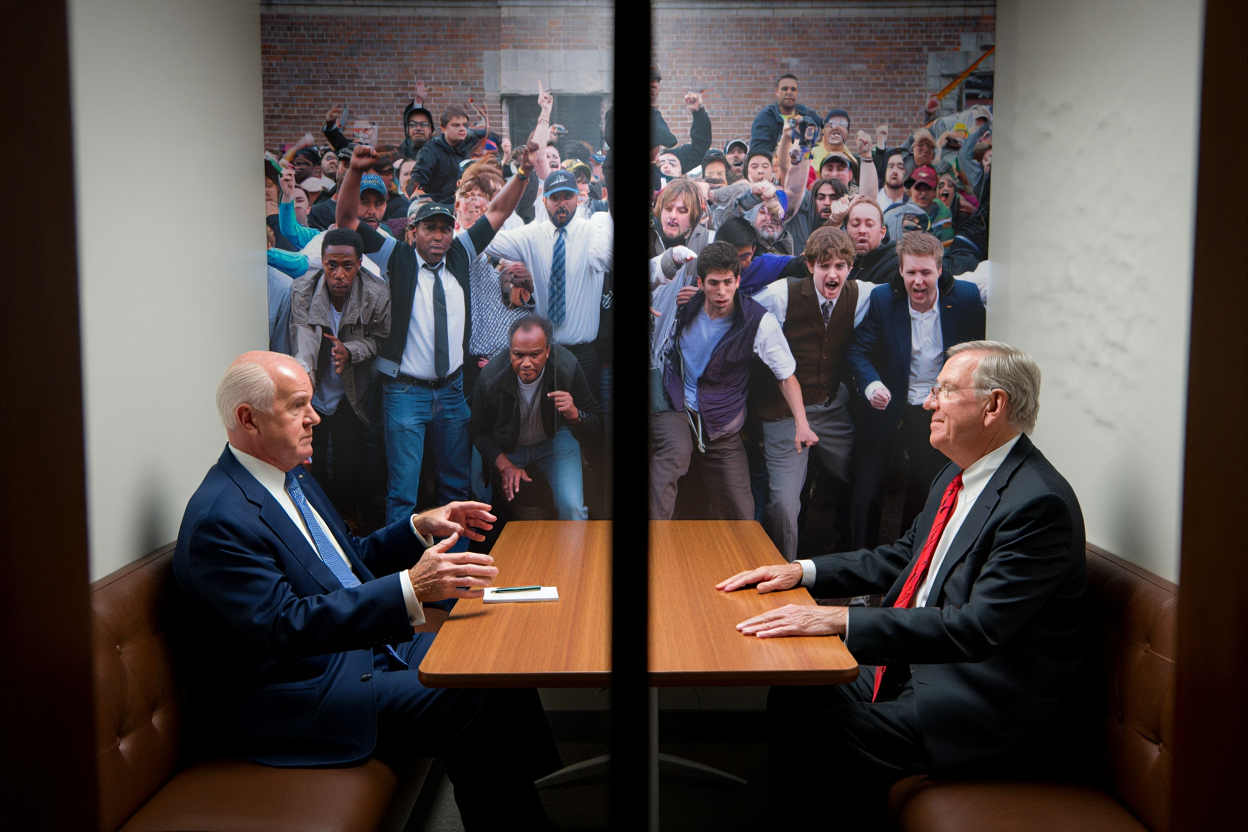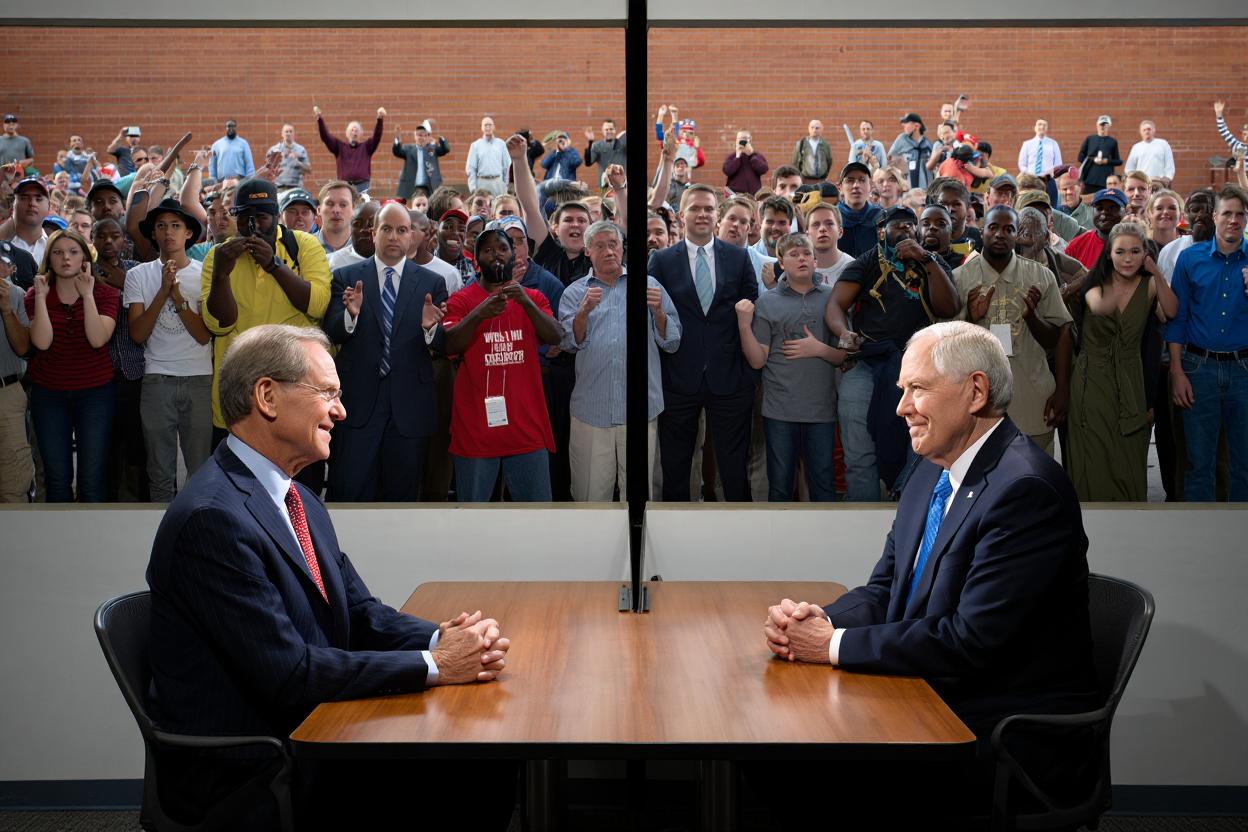CeaseFire at the Crossroads: Deliberative Dialogue in an Age of Polarization
CeaseFire, C-SPAN’s new series debuting fall 2025, seeks to cut through polarization by modeling civil, structured dialogue across divides. But its mission to surface disagreement and mutual respect must overcome deep psychological, social, and media barriers.

By Dennis Stevens, Ed.D.
In fall 2025, C-SPAN will debut CeaseFire, a weekly series explicitly designed to bridge America’s deepening partisan divides through structured, civil dialogue; it is intended to be anti-thesis of Crossfire.
Crossfire was a long-running CNN debate show that began in the 1980s and peaked in the 1990s and early 2000s. Its format pitted a host from the left against one from the right, encouraging sharp, performative clashes over the news of the day. The show became emblematic of cable news’ tendency to turn serious political issues into partisan shouting matches; conflict as spectacle, not substance; news as entertainment in lieu of news in the public interest.
In 2004, comedian Jon Stewart famously went on Crossfire and tore into the hosts for “hurting America,” accusing them of reducing complex debates to hackish point-scoring and empty theatrics. His critique went viral, crystallizing public frustration with the show’s divisive style. Not long after, CNN canceled Crossfire, acknowledging that the gotcha-banter format was out of step with serious journalism.
CeaseFire brings together elected officials and influential voices from opposite sides of the aisle to uncover shared values, clarify real ideological differences, and model respectful civic discourse. Americans have always disagreed and they always will.
Our country was built to withstand factionalism. The Founders understood that divergent interests are inevitable. As James Madison argued in Federalist No. 10, the goal is not to eliminate factions but to design institutions strong enough to contain and balance them.
But this is no simple debate club. The challenge runs deeper than policy disputes; the truth is that Americans hold fundamentally different visions of freedom, equality, family, and the role of government. Yet the old media playbook turns these worldviews into combat sport, rewarding outrage and shallow caricatures.
CeaseFire, C-SPAN’s first major new series in nearly two decades, stands as a deliberate counterweight to that cycle. Launching in fall 2025, it’s positioned as the antithesis of Crossfire: instead of stoking partisan heat, it seeks to lower the temperature, surface disagreements without spectacle, and deliver the honest, constructive civic dialogue that Crossfire so spectacularly failed to achieve.
And, the proof is in the outcome. My preliminary, expert impression is that this may be a bigger and more complex challenge than C-SPAN is prepared to tackle.
CeaseFire: A New C-SPAN Series Premiering Fall 2025
Stated Objective of CeaseFire
CeaseFire’s mission is to create a principled, transparent, and inclusive forum for structured dialogue across America’s ideological chasms. The goal is not to erase disagreement but to surface it thoughtfully, clarify the deeper values and logics that underlie competing perspectives, and cultivate the habits of mutual respect, impartiality, and civic engagement essential to a functioning democracy.

Kumbuya ain't gonna cut it.
There Are Innate Challenges to Advancing CeaseFire’s Objectives
While CeaseFire’s mission is both timely and necessary, its success depends on overcoming profound and often underappreciated structural, psychological, and cultural obstacles.
1. Cognitive Biases and Identity-Protective Cognition
Humans instinctively process information in ways that protect their identity and confirm what they already believe. Decades of research show that viewers will seek and amplify information that affirms their partisan worldview while dismissing counter-evidence. Even the most skillful moderation and framing cannot fully circumvent these built-in biases.
2. Intolerance of Uncertainty
A significant share of the public, and many political actors, prefer simple, binary narratives over nuance. Structured dialogue that maps complex realities can appear threatening, destabilizing, or suspiciously neutral. This resistance to ambiguity undermines efforts to treat multiple perspectives as legitimate or worth deeper exploration.
3. Personality Traits and Emotional Triggers
Traits like low openness to experience and high conscientiousness often correlate with greater rigidity in processing political information. When confronted with conversations that humanize the “other side,” some viewers may react defensively or emotionally, resulting in disengagement or backlash rather than mutual understanding.
4. Us-vs-Them Sectarianism
Affective polarization has fused partisan identity with social belonging. Many Americans view politics through an in-group/out-group lens; the simplistic idea of the forces of light versus the forces of darkness dominates the narrative. Openness to opposing ideas can be perceived as betrayal, making it more difficult for guests or viewers to approach dialogue openly, as a neutral or good-faith exercise. At this stage, the underlying moral philosophy is largely absent from the conversation, which prevents a deeper understanding and a more nuanced interpretive lens.
5. The Myth of Ideological Objectivity
Most people regard their worldview as a self-evident reality, while others are “biased” or “misinformed.” This belief limits the willingness to recognize that all sides operate within socially constructed logics. CeaseFire’s effort to map these logics can be misinterpreted as relativism or false equivalence, especially when moral stakes are high.
6. Social Costs and Group Enforcement
In polarized environments, the social penalties for engaging too sympathetically with ideological opponents can be steep. Fear of ostracism within one’s political tribe reinforces echo chambers and discourages genuine cross-cutting dialogue.
7. Media Incentives and Performative Politics
Mainstream and social media ecosystems reward conflict, outrage, and spectacle—not reasoned deliberation. Guests may be tempted to perform civility for reputational points, while the larger attention economy remains structured to amplify friction, not consensus. Openness to opposing ideas can be perceived as betrayal, making it more difficult for guests or viewers to approach dialogue openly, as a neutral or good-faith exercise. will need to sustain interest without compromising its core values.
Conclusion
CeaseFire represents an admirable and necessary attempt to revive deliberative democratic habits. But it must do so in a cultural and institutional landscape that often punishes nuance and rewards tribalism. Its success will hinge on innovative production formats, rigorous facilitation, and above all, a willingness to make these same obstacles visible to its audience.
To change the habits of mind that threaten civic trust, the program cannot simply model polite conversation; it must also clearly illuminate the psychological, social, and structural dynamics that make such conversations so rare, so vital and so difficult.
Bibliography
- Kahan, D. M. (2017). “Misconceptions, Misinformation, and the Logic of Identity-Protective Cognition.” Cultural Cognition Project.
- Taber, C. S., & Lodge, M. (2006). “Motivated Skepticism in the Evaluation of Political Beliefs.” American Journal of Political Science, 50(3), 755–769.
- Mason, L. (2018). Uncivil Agreement: How Politics Became Our Identity. University of Chicago Press.
- Hetherington, M., & Weiler, J. (2018). Prius or Pickup? How the Answers to Four Simple Questions Explain America’s Great Divide. Houghton Mifflin Harcourt.
- Sunstein, C. R. (2017). #Republic: Divided Democracy in the Age of Social Media. Princeton University Press.
- Hibbing, J. R., Smith, K. B., & Alford, J. R. (2014). Predisposed: Liberals, Conservatives, and the Biology of Political Differences. Routledge.
- Jost, J. T., et al. (2009). “Political Ideology: Its Structure, Functions, and Elective Affinities.” Annual Review of Psychology, 60, 307–337.
- Iyengar, S., & Westwood, S. J. (2015). “Fear and Loathing across Party Lines: New Evidence on Group Polarization.” American Journal of Political Science, 59(3), 690–707.
- Pew Research Center. (2014). “Political Polarization in the American Public.”
- Information is Beautiful. (2023). “Left vs. Right (US).” [Visualization].




